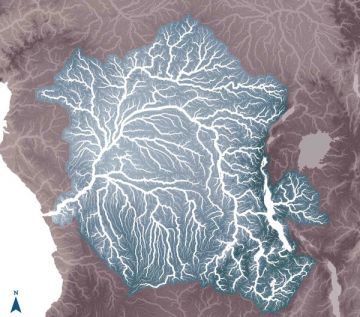An outstanding natural world heritage

Scope - Span of Congo Basin forest ecosystems, Central Africa
The forest ecosystems of the Congo Basin span a land surface area of 301 million to 530 million ha, accounting for roughly 70% of Africa’s forest cover (over 99% of the forested lands are primary or regenerated naturally forests). 46% are found in lowland dense forests (low altitude) (1, 2, 4, 5) , including all forest types in Central Africa found in the following COMIFAC-ECCAS member countries: Angola, Burundi, Cameroon, Gabon and Equatorial Guinea, the Central African Republic, the Democratic Republic of the Congo, the Republic of the Congo, Rwanda, São Tomé and Principe, Chad and some "small" zones in Nigeria and Uganda. These ecosystems are ranked the world’s second largest expanse of dense tropical forests after the Amazon. The Congo Basin forest ecosystems located in Central Africa cover a surface area of 6 613 000 km2 (13)
The Congo Basin - global importance - an outstanding natural heritage
- In terms of conservation of the outstanding and most important biodiversity on the planet
Forests enable direct and indirect job creation, generate and redistribute wealth throughout the value chains of various sectors and help to broaden the tax base, just to name a few benefits. They also provide numerous ecosystem goods and services that help regulate many vital functions on the entire planet. They account for between 4 to 7% of non-oil GDP, with roughly 44 million hectares of forests under concession (approximately 8.3 per cent of the total land surface area) (1, 8), and also contribute significantly to employment and tax revenue. Hunting generally provides 30 to 80 per cent of protein consumed by families living in the Congo Basin forests. In the case of Cameroon, for example, the economic value of bush meat is estimated at 80 billion CFA francs (approximately EUR 122 million) per year (8). Central Africa is rich in natural resources (forests, biodiversity, minerals, oil, rare soils, arable land …), making these ecosystems a huge asset.
About a hundred million people live in this Basin which is the size of India and Paraguay combined, and supports the livelihoods of more than 85 million people (local and indigenous people). The Congo Basin is one of the most ethnically diverse regions on the continent, with more than 250 ethnic groups living in the area. The variety of ethnic groups comes with its own challenges in terms of human rights, management of forests and land: These distinct ethnic groups coexist and live in rural areas, most of which depend directly on forest resources such as NTFPs, bush meat and wood. These communities include groups such as the Ba'Aka, the most famous representatives of an ancient hunter-gatherer lifestyle whose livelihoods and well-being are intricately tied to the forest. Similar groups include: The Ba’ kwele, and the Mbomban. These ethnic groups depend on local natural resources for food, nutritional health and subsistence needs and also help feed 40 million people living in urban centres close to these forest areas (8, 9). Read more… Brochure
- In terms of their economic importance, forests play a vital role in national and local economies.
Forests play a vital role in regulating the climate and storing carbon and are key to mitigating and cushioning (the effects of) climate change. Recent estimates suggest that the Congo Basin holds over 60 billion metric tonnes of carbon, more than all the tropical forests of the Amazon and Asia put together, says a recent study (14). The recently published first ever detailed spatial map of peatlands in the Cuvette Centrale shows that it is the more extensive peatland complex in the tropics, stretching over roughly 145 500 km2, storing an estimated 30.6 pg of carbon (30% of the CO2) and 30 billion tonnes of carbon in its underground swamps, the equivalent of six years of global fossil fuel-related emissions or twenty years of U.S. fossil fuel-related emissions (1, 9, 10). Read more… Brochure
- In terms of rich and diverse populations, cultures and traditions
Home to 1 in 5 living species on our planet, especially a diverse range of primate species, the region is one of the most important biodiversity hotspots in the world. This biodiversity is unique both in terms of its significant variety and highly endemic fauna and flora. Hence the ecosystems form a spectacular melting pot and reservoir of biodiversity, harbouring Africa’s most diverse mix of endemic and iconic plants and animals, including 20,000 plant species (of which 8,000 are endemic), 1,300 bird species, 336 amphibian species, 400 reptile species and 400 mammal species (10% of which are endemic) with a sizeable proportion listed in a category of the IUCN Red List. Central Africa is also home to the largest populations of forest elephants and chimpanzees, covering almost the entire geographical range of the western lowland and mountain gorillas, as well as the bonobo, the okapi, the Bongo and the aquatic Genette. Several small primates and antelope species are also endemic to and populate these lush forests. Sixteen bird species and 23 mammal, gorillas and other great apes’ species are considered as being threatened, endangered or critically endangered, although the figures could be much higher. More than 200 animal species that new to science have been described in the region since 2000 and there are still others to be “discovered" (3, 6, 8). Read more… Brochure
- In terms of carbon storage - Global climate regulation and unique peatlands
Share: